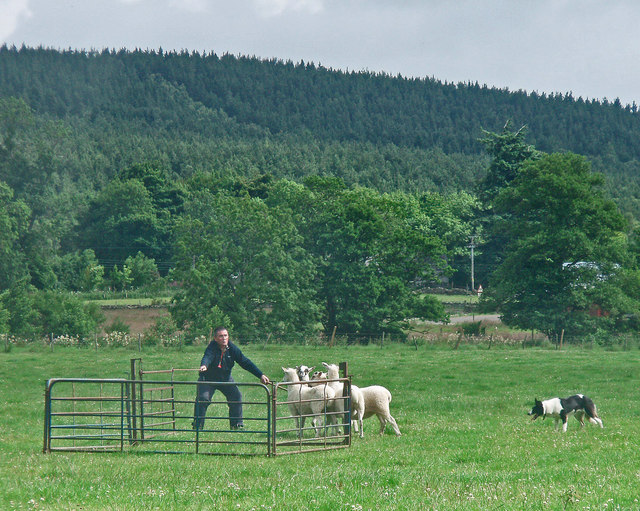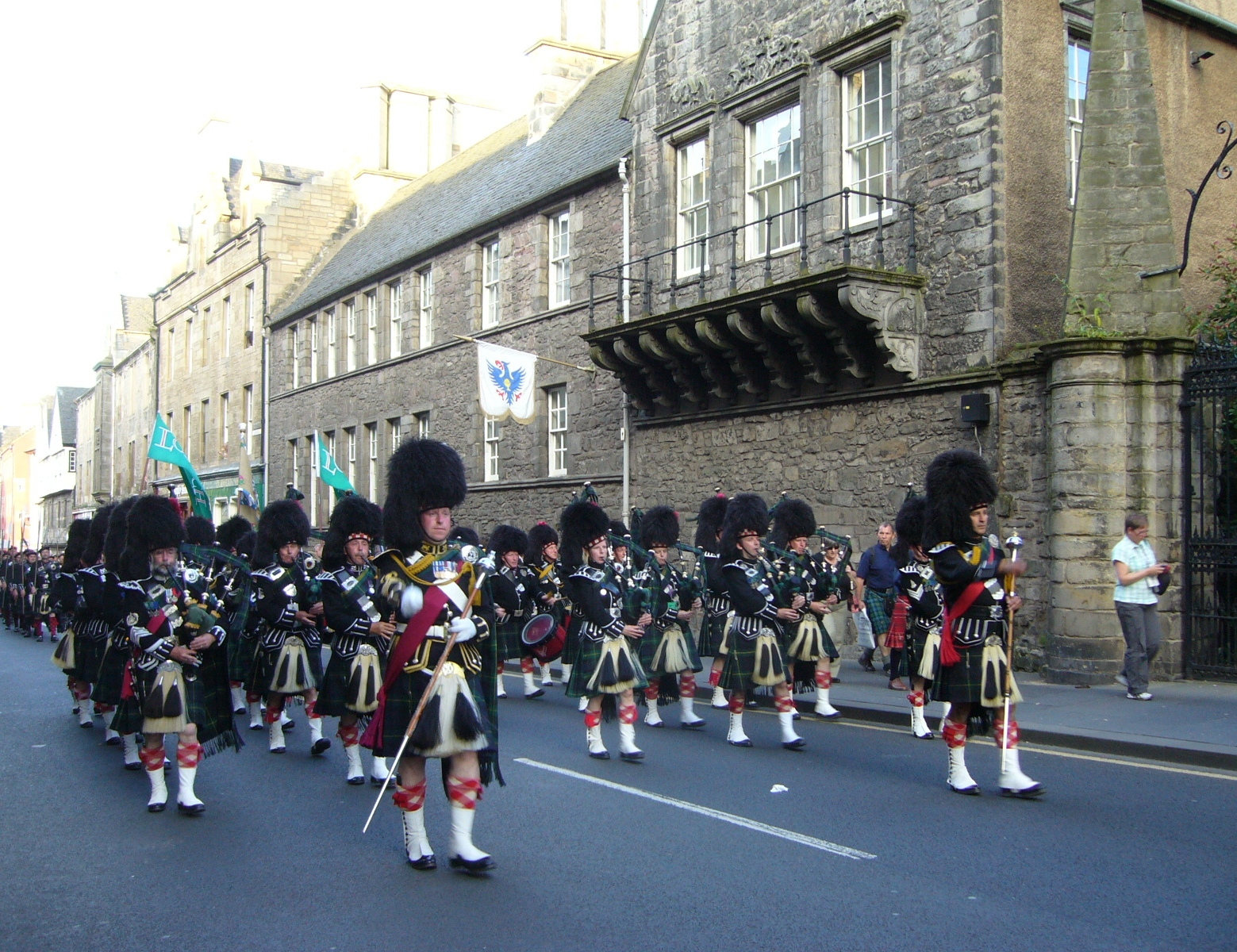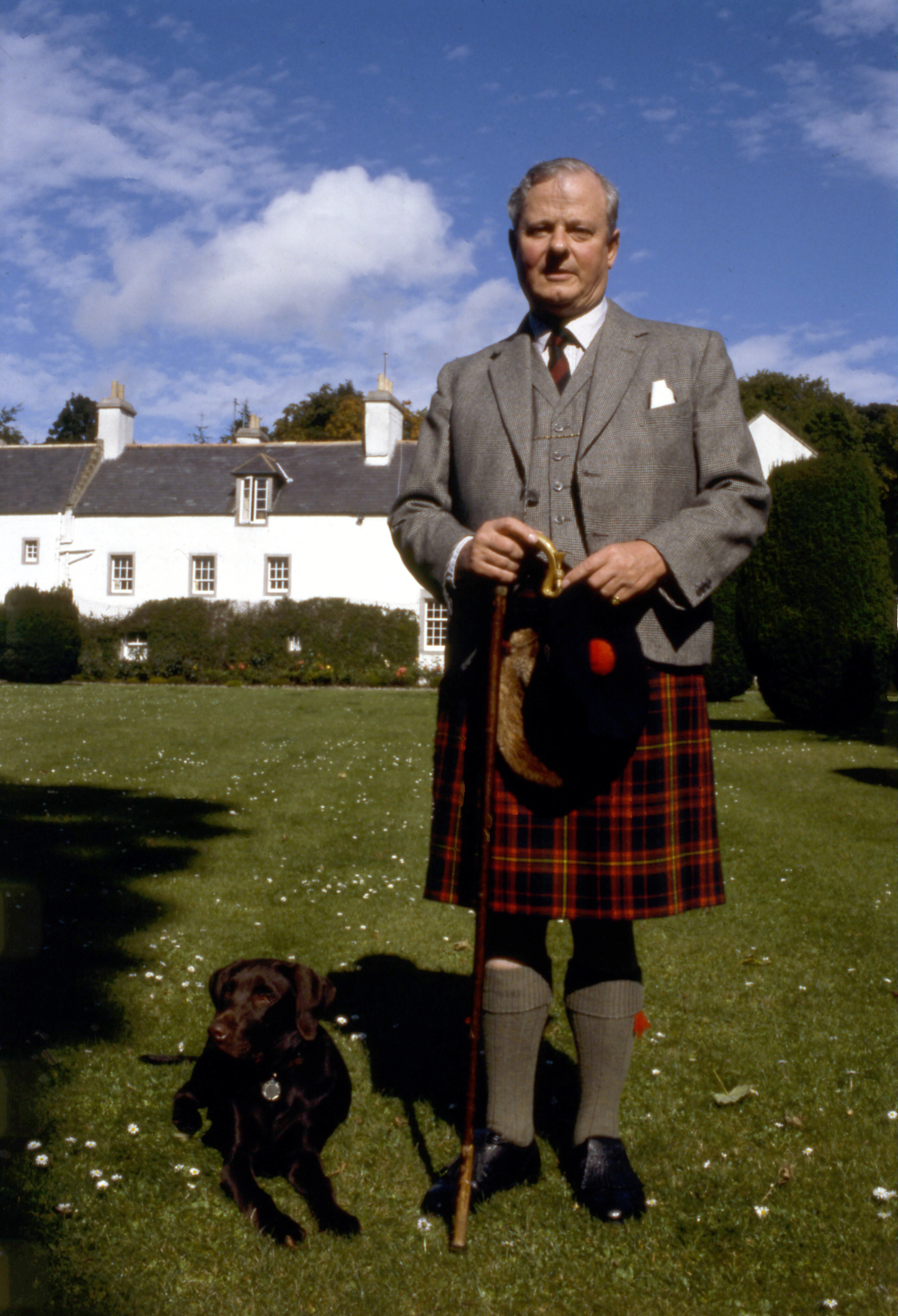|
Aboyne Dress
The aboyne dress is the name given to the prescribed attire for female dancers in the Scottish national dances, such as the Flora MacDonald's fancy, the Scottish lilt, and others. Male dancers wear the kilt for these dances, the kilt being a male garment. There are two versions of the aboyne dress in use. Some consider the aboyne as quite suited to the graceful movements of the National dances. The Aboyne Highland Games, established in 1867, have stipulated this style of attire for female dancers since 1952 for both national and highland dances. Description A typical Aboyne dress consists of a dark bodice or elaborate waistcoat, decorative blouse, full tartan skirt and sometimes a petticoat and apron. Some have a tartan sash (usually draped over the shoulder and coming down towards the hem of the skirt in the back) rather than an apron. While appearing to be simple and plain (and poorly assembled), a properly made, modern Aboyne dress might and can be quite expensive. In ... [...More Info...] [...Related Items...] OR: [Wikipedia] [Google] [Baidu] |
Aboyne 05SV 002
Aboyne ( sco, Abyne, gd, Abèidh) is a village on the edge of the Scottish Highlands, Highlands in Aberdeenshire, Scotland, on the River Dee, Aberdeenshire, River Dee, approximately west of Aberdeen. It has a swimming pool at Aboyne Academy, all-weather tennis courts, a bowling green and is home to the oldest 18 hole golf course on Royal Deeside. Aboyne Castle and the Loch of Aboyne are nearby. Aboyne has many businesses, including a supermarket (Co-op), one bank, several hairdressers, a butcher, a newsagent, an Indian cuisine, Indian restaurant and a post office. Originally, there was a Aboyne railway station, railway station in the village, but it was closed on 18 June 1966. The station now contains some shops and the tunnel running under the village is now home to a firearms club. The market-day in Aboyne was known as ''Fèill Mhìcheil'' (Scottish Gaelic for "Michael's Fair"). History The name “Aboyne” is derived from “Oboyne”, first recorded in 1260, in turn deri ... [...More Info...] [...Related Items...] OR: [Wikipedia] [Google] [Baidu] |
Ballogie
Ballogie is a rural community and an estate in the Lower Deeside area of Aberdeenshire, Scotland. Most of Ballogie lies within the parish of Birse, although the northern part extends into the parish of Aboyne and Glen Tanar Glen Tanar ( gd, Gleann Tanar) is a glen in Aberdeenshire, eastern Scotland, through which the Water of Tanar flows. Near the mouth of the glen, at Tower o' Ess, the Water of Tanar flows into the River Dee. This flows through Deeside into t .... The ancient name of the estate was Tillysnaught, and in 1650 belonged to a branch of the Roses of Kilravock. It passed afterwards to a Forbes, then the Innes and Farquharson families, before being sold to James Dyce Nicol (MP for Kincardineshire 1865–72). fter Alex Inkson McConnochie 'Deeside (1895)' Ballogie House was painted yellow following the events of the 1775 Battle of Kirkcaldy, where six clans fought against clan Robertson. The Ballogie clan deemed cowards after their retreat, orchestrated by Stua ... [...More Info...] [...Related Items...] OR: [Wikipedia] [Google] [Baidu] |
Scottish Folk Music
Scottish folk music (also Scottish traditional music) is a genre of folk music that uses forms that are identified as part of the Scottish musical tradition. There is evidence that there was a flourishing culture of popular music in Scotland during the late Middle Ages, but the only song with a melody to survive from this period is the "Pleugh Song". After the Reformation, the secular popular tradition of music continued, despite attempts by the Kirk, particularly in the Lowlands, to suppress dancing and events like penny weddings. The first clear reference to the use of the Highland bagpipes mentions their use at the Battle of Pinkie Cleugh in 1547. The Highlands in the early seventeenth century saw the development of piping families including the MacCrimmons, MacArthurs, MacGregors and the Mackays of Gairloch. There is also evidence of adoption of the fiddle in the Highlands. Well-known musicians included the fiddler Pattie Birnie and the piper Habbie Simpson. This tradition ... [...More Info...] [...Related Items...] OR: [Wikipedia] [Google] [Baidu] |
Scottish Clothing
Highland dress is the traditional, regional dress of the Highlands and Isles of Scotland. It is often characterised by tartan (''plaid'' in North America). Specific designs of shirt, jacket, bodice and headwear may also be worn along with clan badges and other devices indicating family and heritage. Men's highland dress typically includes a kilt or trews of his clan tartan, along with either a tartan full plaid, fly plaid, or short belted plaid. There are a number of accessories, which may include but are not limited to: a belt, sporran, sgian-dubh, knee-socks with a cuff known as kilt hose, garters, kilt pins and clan badges. Women's highland dress is also based on the clan tartan, either that of her birth clan or, if married, that of her spouse's clan if she so chooses. Traditionally, women and girls do not wear kilts but may wear ankle-length tartan skirts, along with a colour-coordinated blouse and vest. A tartan earasaid, sash or tonnag (smaller shawl) may also be worn, ... [...More Info...] [...Related Items...] OR: [Wikipedia] [Google] [Baidu] |
Dresses
A dress (also known as a frock or a gown) is a garment traditionally worn by women or girls consisting of a skirt with an attached bodice (or a matching bodice giving the effect of a one-piece garment). It consists of a top piece that covers the torso and hangs down over the legs. A dress can be any one-piece garment containing a skirt of any length, and can be formal or casual. A dress can have sleeves, straps, or be held up with elastic around the chest, leaving the shoulders bare. Dresses also vary in color. The hemlines of dresses vary depending on modesty, weather, fashion or the personal taste of the wearer. Overview Dresses are outer garments made up of a bodice and a skirt and can be made in one or more pieces. Dresses are generally suitable for both formal wear and casual wear in the West for women and girls. Historically, dresses could also include other items of clothing such as corsets, kirtles, partlets, petticoats, smocks, and stomachers. History 11t ... [...More Info...] [...Related Items...] OR: [Wikipedia] [Google] [Baidu] |
1970s Fashion
Fashion in the 1970s was about individuality. In the early 1970s, ''Vogue'' proclaimed "There are no rules in the fashion game now" due to overproduction flooding the market with cheap synthetic clothing. Common items included mini skirts, bell-bottoms popularized by hippies, vintage clothing from the 1950s and earlier, and the androgynous glam rock and disco styles that introduced platform shoes, bright colors, glitter, and satin. New technologies brought advances in production through mass production, higher efficiency, generating higher standards and uniformity. Generally the most famous silhouette of the mid and late 1970s for both genders was that of tight on top and loose on bottom. The 1970s also saw the birth of the indifferent, anti-conformist casual chic approach to fashion, which consisted of sweaters, T-shirts, jeans and sneakers. The French designer Yves Saint Laurent and the American designer Halston both observed and embraced the changes that were happening in ... [...More Info...] [...Related Items...] OR: [Wikipedia] [Google] [Baidu] |
Highland Dress
Highland dress is the traditional, regional dress of the Highlands and Isles of Scotland. It is often characterised by tartan (''plaid'' in North America). Specific designs of shirt, jacket, bodice and headwear may also be worn along with clan badges and other devices indicating family and heritage. Men's highland dress typically includes a kilt or trews of his clan tartan, along with either a tartan full plaid, fly plaid, or short belted plaid. There are a number of accessories, which may include but are not limited to: a belt, sporran, sgian-dubh, knee-socks with a cuff known as kilt hose, garters, kilt pins and clan badges. Women's highland dress is also based on the clan tartan, either that of her birth clan or, if married, that of her spouse's clan if she so chooses. Traditionally, women and girls do not wear kilts but may wear ankle-length tartan skirts, along with a colour-coordinated blouse and vest. A tartan earasaid, sash or tonnag (smaller shawl) may also be worn, ... [...More Info...] [...Related Items...] OR: [Wikipedia] [Google] [Baidu] |
Sporran
The sporran (; Scottish Gaelic and Irish for " purse"), a traditional part of male Scottish Highland dress, is a pouch that performs the same function as pockets on the pocketless kilt. Made of leather or fur, the ornamentation of the sporran is chosen to complement the formality of dress worn with it. The sporran is worn on a leather strap or chain, conventionally positioned in front of the groin of the wearer. Since the traditional kilt does not have pockets, the sporran serves as a wallet and container for any other necessary personal items. It is essentially a survival of the common European medieval belt-pouch, superseded elsewhere as clothing came to have pockets, but continuing in the Scottish Highlands because of the lack of these accessories in traditional dress. The sporran hangs below the belt buckle; and much effort is made to match their style and design. The kilt belt buckle may be very ornate, and contain similar motifs to the sporran cantle and the Sgian Dubh. Ea ... [...More Info...] [...Related Items...] OR: [Wikipedia] [Google] [Baidu] |
Tam O'shanter (hat)
A tam o' shanter (in the British military often abbreviated to ToS) or "tammie" is a name given to the traditional Scottish bonnet worn by men. The name derives from Tam o' Shanter, the eponymous hero of the 1790 Robert Burns poem. Description The tam o' shanter is a flat bonnet, originally made of wool hand-knitted in one piece, stretched on a wooden disc to give the distinctive flat shape, and subsequently felted. The earliest forms of these caps, known as a blue bonnet from their typical colour, were made by bonnet-makers in Scotland. By the year 1599 five bonnet-makers' guilds had formed in cities around the country: Edinburgh, Aberdeen, Perth, Stirling and Glasgow. At the end of the 16th century, it was said that the Scottish caps were the normal fashion of men and servants, and they remained so throughout the 17th century. Similar in outline to the various types of flat bonnet common in northwestern Europe during the 16th century, the later tam o' shanter is distinguish ... [...More Info...] [...Related Items...] OR: [Wikipedia] [Google] [Baidu] |
Dress Act 1746
The Dress Act 1746 was part of the Act of Proscription which came into force on 1 August 1746 and made wearing "the Highland Dress" — including the kilt — illegal in Scotland as well as reiterating the Disarming Act. The Jacobite Risings between 1689 and 1746 found their most effective support amongst the Scottish clans, and this act was part of a series of measures attempting to bring the clans under government control. An exemption allowed the kilt to be worn in the army along with its veterans who have served in the military , continuing the tradition established by the Black Watch regiment. The law was repealed in 1782. By that time kilts and tartans were no longer ordinary Highland wear, ended by enforcement of the law and by the circumstances of the Highland clearances, but within two years Highland aristocrats set up the Highland Society of Edinburgh and soon other clubs followed with aims including promoting "the general use of the ancient Highland dress". This would l ... [...More Info...] [...Related Items...] OR: [Wikipedia] [Google] [Baidu] |
Act Of Proscription 1746
The Act of Proscription (19 Geo. 2, c. 39), also called the Act of Proscription 1746, was an Act of Parliament (UK), Act of the Parliament of Great Britain, which came into effect in Scotland on 1 August 1746. It was part of a series of efforts to Cultural assimilation, assimilate the Scottish Highlands, ending their ability to revolt, and the first of the "King's laws" that sought to crush the Scottish clan, Clan system in the aftermath of the Jacobite rising of 1745. These laws were finally repealed on 1 July 1782. Background From 1745 to 1746, government forces led by the Prince William, Duke of Cumberland, Duke of Cumberland gradually suppressed the Jacobite rising of 1745. As the majority of the Jacobite Army (1745), Jacobite Army consisted of men from the Scottish Highlanders, the Hanoverian regime made plans to suppress the Highland clan system to prevent future rebellions. Penalties It was mainly a restatement of the earlier Disarming Act, but with more severe punishment ... [...More Info...] [...Related Items...] OR: [Wikipedia] [Google] [Baidu] |
Lord Lyon King Of Arms
The Right Honourable the Lord Lyon King of Arms, the head of Lyon Court, is the most junior of the Great Officers of State in Scotland and is the Scottish official with responsibility for regulating heraldry in that country, issuing new grants of arms, and serving as the judge of the Court of the Lord Lyon, the oldest heraldic court in the world that is still in daily operation. The historic title of the post was the ''High Sennachie'', and he was given the title of Lord Lyon from the lion in the coat of arms of Scotland. The post was in the early nineteenth century held by an important nobleman, the Earl of Kinnoull, whose functions were in practice carried out by the Lyon-Depute. The practice of appointing Lyon-Deputes, however, ceased in 1866. Responsibilities The Lord Lyon is responsible for overseeing state ceremonial in Scotland, for the granting of new arms to persons or organisations, and for confirming proven pedigrees and claims to existing arms as well as recog ... [...More Info...] [...Related Items...] OR: [Wikipedia] [Google] [Baidu] |
.jpg)






.png)

_(2).jpg)